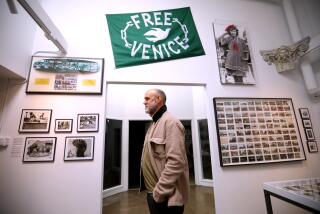Venice’s first female gondolier pushes off into uncharted waters
- Share via
VENICE, ITALY — As a little girl in Venice, Giorgia Boscolo was forever bugging her father to let her ride with him in his gondola. While her three sisters played with their dolls, she would beg him for a turn with the remo, or oar.
Dante Boscolo, an indulgent Italian father, humored his pint-sized shadow -- to a point.
“My father only let me row when it was bad weather,” Giorgia recalled with a laugh.
His retort was swift: “That’s how you learn.”
Learn she did. Last month, the 23-year-old mother of two calmly took her place in one of Venice’s storied gondolas and gently steered the sleek black boat straight into the annals of history.
With the splash of her oar, nine centuries of taboos in this romantic canal city shattered as Boscolo passed a rigorous exam of brains and brawn to become Venice’s first official female gondolier -- or gondoliera in Italian, a term that didn’t even exist until her achievement made it necessary.
The waters have been choppy at times, and not just in the canals, but Boscolo at last feels in her element.
“I was born among gondoliers,” she said on a languorous afternoon brilliant with sunshine. “It’s the only job I’ve ever wanted.”
Boscolo’s breakthrough propelled her into the ranks of what can no longer be described with complete accuracy as an elite fraternity, made up of bluff and hearty boatmen whose presence along Venice’s winding waterways seems as timeless as the city itself.
Fewer than 500 gondoliers are licensed to navigate Venice’s network of 150 canals. They’re a fairly macho bunch, instantly recognizable in their jaunty black-and-white-striped shirts, lounging lazily against the bank-side walls waiting for tourists to hire them or letting loose the occasional low whistle at women who walk by.
They are heirs to a tradition stretching back nearly a millennium, when the signature banana-shaped boats first began plying the waters as a quick and easy means of transport. The men who captained them became indispensable fixtures around the Venetian lagoon, proud of their skill and bonded by shared experience.
As is inevitable when such a testosterone-laden citadel is breached, not all of Boscolo’s new colleagues have been thrilled about her entry into their midst. Some grumble sotto voce that she’s become too big for her britches, upending the old order and hogging all the attention.
Boscolo shrugs off the criticism with the same determined cool that got her here in the first place.
“The important thing is to do what you want to do,” she declared.
Whether she sought it or not, there’s no doubt that Boscolo commands the spotlight. When it was announced at the end of June that she had qualified, just barely, as an apprentice gondolier, the media hordes swooped in.
TV stations jockeyed for airtime with the telegenic blond. A savvy entrepreneur swiftly turned Boscolo and her boatman father into pinup models, featuring them together as Mr. and Ms. April in a 2010 calendar of sexy gondoliers that hit stores within days.
“I didn’t expect it,” she said, shaking her head at the feeding frenzy. “Every phone call was a different journalist.”
Rumors spread that she’d hired a smooth-talking agent to handle her affairs and was demanding money for interviews. Boscolo has denied those reports, saying she merely delegated the task of fielding so many calls and requests to one of her sisters and that the only payment she has asked for was reimbursement for the cost of traveling to Milan for an interview.
Still, the hype rang alarm bells at the gondoliers guild, the centuries-old guardian of gondoliering tradition. The association presides over what remains a tightly controlled, almost feudally organized trade that regulates even the smallest of details, down to the width of the stripes on the gondoliers’ shirts and the hefty fines they must pay for infractions of the official code of conduct.
Guild officials warned Boscolo to rein in her newfound celebrity or risk losing her apprenticeship.
“The honor and history of the gondoliers cannot be commercialized, not even if we’re talking about the first woman to be authorized to take up an oar,” Aldo Rosso, guild president, told a local newspaper.
Boscolo has apologized for any offense, reiterating that her only desire was to complete her training and realize the dream she’s held since girlhood.
Her father, Dante, 56, is about to hang up his gondolier’s shirt after four decades of gliding around Venice. Without a son, he can’t carry out the time-honored tradition of passing the job down the male line. He knows Giorgia is passionate about the work -- “it’s in her DNA” -- but his attitude isn’t exactly progressive.
“I’m very proud of her, but I still have to say that it’s not a job for a woman, even though she’s my daughter. But you know, in modern times, women are doing a lot of jobs that used to belong to men,” he said.
He squeezed his daughter’s biceps and considered a moment. “She needs a bit more muscle,” he said.
Strength is certainly a big part of the job: The narrow wooden boats weigh more than half a ton and seat more than a dozen passengers, yet are steered by a single long oar. (Yes, it’s physically taxing, Boscolo says to any male skeptics, but try childbirth.)
Captains must also speak good English, learn the history of Venice and its gracious palazzos, understand aspects of maritime law and demonstrate complete knowledge of the intricate canal system.
Just to become an apprentice, would-be gondoliers must show that they’ve mastered the basics: the proper way to embark, push off, steer and row, using a technique unique to gondolas known as voga alla veneta, where the rower stands and faces in the direction the boat is traveling.
Gondoliers’ fares are regulated but hardly cheap -- 100 euros (about $140) for a 50-minute evening tour, more if the customer wants to be serenaded. But gondoliers say expenses and the cost of living are high.
“I hate this job,” said one who asked not to be named. “You all think we just do this job like that” -- he snapped his fingers -- “but it takes long years of training. It’s like university.”
Boscolo took the entry test for the first time in 2007 and failed, placing 43rd out of 140 candidates; only the top 40 were accepted. She tried again last year -- and failed a second time, falling just short of the final cut of 15.
Last month, on her third attempt, Boscolo came in 22nd out of a field of about 85 applicants. Officials announced the cutoff line: 22.
“I knew I did well,” Boscolo said. But having suffered the disappointment of two near-misses, she said, “I didn’t expect to get in.”
Two other women failed to pass, including a German American named Alexandra Hai, who has applied for years. Hai has accused the guild of discriminating against female candidates and judging them more harshly than men, a charge officials deny.
Boscolo’s apprenticeship began this month, a probationary period lasting several months during which she can serve as a substitute gondolier and as a sort of first officer to the captain in a two-crew boat.
Her training will also present her with the new challenge of juggling work with being a good mother to her two sons, ages 5 and 3.
Boscolo’s 26-year-old husband, Simone Ferrotti, is supportive of his wife’s budding career, perhaps because he knows it would be futile to be otherwise. “Ever since I met her, she’s always wanted to be with her dad in the gondola,” said Ferrotti, a metalworker.
Boscolo isn’t worried about potentially sexist behavior from other gondoliers. Her father is well-known among them, and some of his colleagues, old salts with years of experience, helped her train for the exam.
To have joined their company and become part of a centuries-old tradition, one that practically symbolizes this rich and storied city, is an honor.
“It’s impossible to think about Venice without thinking of gondoliers,” Boscolo said.
And now, perhaps, of a gondoliera.
--
Times staff writer Maria De Cristofaro contributed to this report.
More to Read
Sign up for The Wild
We’ll help you find the best places to hike, bike and run, as well as the perfect silent spots for meditation and yoga.
You may occasionally receive promotional content from the Los Angeles Times.







